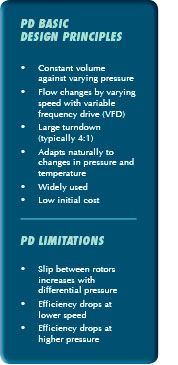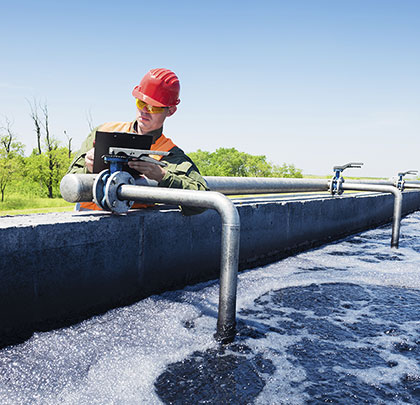Given numerous variables when selecting an aeration blower system for wastewater applications, and equally numerous claims by technology providers, it is not surprising that confusion exists. Worse than confusion is the disappointment that results when a blower technology fails to perform as anticipated — and operating cost and efficiency benefits go unrealized.
This guide explains three blower technologies and, using examples from actual wastewater plants, describes the most effective technology for particular applications and why. Of course there is no substitute for a consultation specific to your application; however, the guide can help raise the right questions and ensure a productive vendor and technology evaluation process.
INTRODUCTION
Energy consumption and cost have been the key drivers behind the development of more efficient aeration blower systems. These systems can account for as much as 60 percent of the total energy consumption of a wastewater treatment plant (WWTP). Therefore, the payback on greater energy efficiency is significant.
Technological advancements in aeration blowers are providing new options for reducing energy consumption. However, these options also require greater understanding of the overall system and fluctuations in operating conditions in order to optimize the total cost of ownership and maximize return on investment.
If the choice of an aeration blower was simply based on the energy efficiency or initial cost of the technology—irrespective of the operating conditions—it would be easy to select the most effective aeration blower. However, once installed, the cost-benefit intended is not likely to be achieved if the technology is misapplied.

An accurate cost-benefit analysis must include the capital expenditure of the aeration blowers themselves, and the operating variables. Consider daily and seasonal swings in oxygen demand, fouling and aging of diffusers, air flow control and turndown capabilities, total blower efficiency and energy consumption over time, mode of operation, blower accessories, and plant set up when making your decision.
Operating variables can significantly affect cost and benefit. With energy efficiency the primary driver of aeration blower technology, the goal of this paper is to illustrate the most efficient and cost-effective way to achieve energy efficiency based on real-world applications and right-sizing blower technologies.

AN OVERVIEW OF CURRENT BLOWER TECHNOLOGIES
There are four main blower solutions for wastewater aeration applications: positive displacement blowers, turbo blowers, hybrid blowers, and combination blower technologies. The following sections provide brief introductions to these approaches and outline the benefits and limitations of each.
Positive Displacement (PD) Blowers
These blowers are defined as rotary lobe blowers with straight or twisted lobe rotors without internal compression. Often, they are referred to as “the workhorse” for its flexibility to perform well despite changing conditions; the PD blower has a lower initial cost than its turbo and hybrid counterparts. However, the PD blower’s lower cost can be offset by higher energy consumption, depending upon the operating conditions. When it comes to turndown, PD far exceeds turbo blower technology by achieving ratios as high as 4:1.

Turbo Blowers
When operating near its design point, the turbo technology may be the most efficient ad therefore performs cost-effectively in applications with narrow swings in turndown. Turbo has a higher initial cost than its rotary lobe and hybrid counterparts. However, in applications with less variation in operating conditions, the additional cost can be compensated for in lower energy consumption.
Centrifugal design principles include dynamic compression, a “sweet zone” of highest efficiency, as well as a guideline to operate on a performance map. If the flow is too low or pressure too high, users can expect a surge. Conversely, if the flow is too high or pressure too low, users can expect a choke. Also, performance varies with air density: summer means high loads in low air density, and winter means low loads in high density.

Hybrid (Rotary Lobe Compressors) Blowers
This technology provides energy efficiency comparable to turbo and the flexibility of PD technology. The hybrid uses a low-pressure screw rotor instead of a straight or twisted rotary lobe rotor. In applications with large swings in flow and pressure, hybrid blowers can achieve rates as low as 25 percent of the original design point.
Hybrid design principles include constant volume against varying pressure with a large turndown (typically 4:1). Also, flow changes by varying speed (via use of a VFD) and rotors mesh, compressing air inside housing.

Combination Blower Technologies
For large WWTPs, applying a combination of blower technologies at various points in the treatment process can improve overall energy efficiency and reduce initial and long-term operating costs. This solution can be especially effective in a retrofit application and in processes where the duty cycle on the blower can be as low as running only one hour per day.
Turbo blowers are ideal for applications where they can run at the same speed all day—they are less efficient when used in applications with regular fluctuations. The best way to optimize a system is to combine a turbo (for base load) with a hybrid (for peak load and low flow conditions).
It is critical that the turbo is able to tolerate the introduction of the hybrid without surging. The idling feature and the current-based inverter control easily facilitate this combination. It is also critical that the PD or hybrid be equipped with pulsation attenuation, to minimize the disturbances in the system while operating with the turbo. Overall energy efficiency can be higher with this approach, and the overall turndown range can be extended to 6:1 or more.
A LOOK AHEAD
Next month, we’ll take a closer look at case studies illustrating the results that can be achieved by implementing turbo, hybrid, and combination blower technologies in wastewater treatment plants. After seeing the results in action, most wastewater professionals feel more confident in making their next blower selection the right one to fit their needs. ■
For More Information
Aerzen USA offers a wide array of Positive Displacement Blowers, High-Speed Turbo Blowers, Screw Compressors, Rotary Lobe Compressors, and Vacuum Pumps for various industries. For more information, visit www.aerzenusa.com.
MODERN PUMPING TODAY, January 2015
Did you enjoy this article?
Subscribe to the FREE Digital Edition of Modern Pumping Today Magazine!


